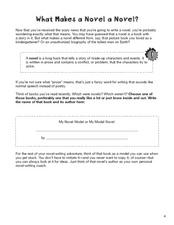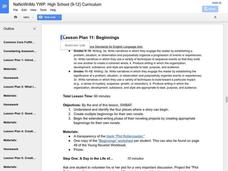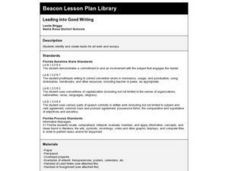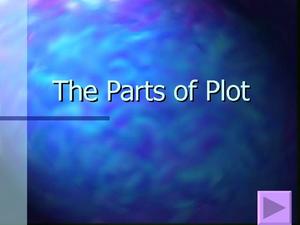Curated OER
What Makes a Novel a Novel?
As your authors prepare to write a hypothetical novel, they need all the inspiration they can find! Using a book they have already read (and enjoyed), learners complete a literary analysis by filling in eight short-answer questions....
Curated OER
Lesson Plan 11: Beginnings
Every good novel needs a solid beginning! Setting the stage can have your budding authors stumped, so use this lesson to get them thinking. After examining the plot rollercoaster image (included) they consider the four places their story...
Curated OER
Leading into Good Writing
Discuss the importance of a lead in writing with your upper graders. They examine several examples of leads from literature and practice writing leads for pieces of artwork. They then select a topic from a list and write an introductory...
Curated OER
Expository Journal Prompts
Stuck for a journal topic? Download CAHSEE’s 21 “Expository Journal Prompts” as a pdf handout for yourself or class. A great resource for your writing program, print it up and add it your curriculum library.
Curated OER
Unforgettable...
Middle and high schoolers remember their most memorable experiences, and then connect their own narrative with an exposition about the topic associated with their experience. This New York Times instructional activity would be a great...
Texas Education Agency (TEA)
Isolated Scenes and Plot Support (English II Reading)
And the plot thickens! The third interactive in this series introduces young scholars to the cause-and-effect nature of a fictional story plot. They learn about the characteristics of exposition, rising action, climax, falling action,...
K20 LEARN
Introduction to Expository Writing
Move beyond the five-paragraph essay with a lesson introducing young writers to various forms of expository writing. Class members examine description, cause and effect, problem solution, sequence, and comparison forms. They create an...
PBS
The Power of Personal Narrative
Personal narratives are powerful things. Whether told from the first-person or third-person point of view, whether in the form of an essay, a short story, novel, or video, whether fiction or fact, they capture readers and give them...
All-in-One High School
Elements of Plot
Cinderella wants to go to the ball and marry the prince. At the end of the story, she does! But how does the plot move from the exposition to the resolution? Teach language arts learners and fairy tale fans about the basics of plot...
West Contra Costa Unified School District
Expository Writing in Math
Pupils engage in an activity where one partner reads directions while the other follows those directions to complete a math task (such as bisecting an angle). As a reflection, they examine products to see what information the best...
Maine Content Literacy Project
Introduction to John Updike
Expand your pupils' understanding of the short story genre with a study of John Updike and his story "A&P." This lesson, the fourth in a series of fourteen, invites learners to examine literary terms and read and discuss the story....
Maine Content Literacy Project
Dramatic Structure of the Short Story
The second lesson in a series of fourteen, this plan takes the short story basics a step further. Learners complete a quiz about the story from the previous day, discuss the text, learn about Anton Chekhov, and work in groups to begin...
Curated OER
Parts of Plot
Questions are given on each slide of this presentation, asking learners to identify parts of plot. The questions have two answers per slide for readers to choose between, multiple-choice style. The last two slides are labeled "Great Job"...
Curated OER
Story Elements
Middle schoolers in particular will benefit from this simple presentation. Forty slides cover story elements like the protagonist, antagonist, and setting, and literary devices are also included. Some examples are given, but for the most...
Curated OER
Storytelling in the Oral Tradition
Seventh graders research Greek mythological characters. They write about problems faced by middle school-aged children and how the character would handle them. Students also create story boards to accompany their oral narratives.
Curated OER
Building Fiction: Elements of a Short Story
Students define and interpret the elements found in a short story. Then they identify the elements of plot found in a short story. Students also apply knowledge of plot to an original work of fiction. Finally, they identify the...
Curated OER
Transportation at the Fair
Students practice map reading, study modes of transportation, and use a map to interpret the past. They imagine a day at the fair to demonstrate knowledge of the role transportation systems play in a community.
Curated OER
Short Story Framework
The class gets creative after listening to a short story containing a definitive structure. They are required to think about character, relationship, and setting, while attempting to show rather than tell, in their writing. Dialogue,...
Curated OER
Sonata Form
In this sonata form worksheet, students examine the three main portions of the sonata form. They read about the exposition, recapitulation, and the development. There are no questions associated with this worksheet about the Classical...
Georgia Department of Education
Ga Virtual Learning: "Lamb to the Slaughter" Study Guide [Pdf]
This is a two-page study guide for "Lamb to the Slaughter" by Roald Dahl. It focuses on characters. point of view, exposition, theme, tone, and comprehension.
Georgia Department of Education
Ga Virtual Learning: Fable Chart [Pdf]
This is a PDF Fable Chart designed for students to complete as they read a fable; it includes the title and author, the animal character, human characteristics, the individual elements of a short story, and the moral or lesson.
Northern Virginia Community College
Introduction to Theatre Plot
This site contains, in outline form, Aristotle's "six parts of a tragedy." The Plot is discussed in length on this site. The author goes into the exposition, conflict, climax, and resolution of the plot.
Annenberg Foundation
Annenberg Learner: Interactives: Elements of a Story
Explore the elements of a story using the well-known Cinderella story as source material. Learn about setting, character, sequence, exposition, conflict, climax, and resolution.
Annenberg Foundation
Annenberg Learner: Story Elements Using Cinderella
Listen to an explanation of the story elements in Cinderella including exposition, characters, setting, sequence, conflict, climax, and resolution.





















![Ga Virtual Learning: "Lamb to the Slaughter" Study Guide [Pdf] Unknown Type Ga Virtual Learning: "Lamb to the Slaughter" Study Guide [Pdf] Unknown Type](https://d15y2dacu3jp90.cloudfront.net/images/attachment_defaults/resource/large/FPO-knovation.png)